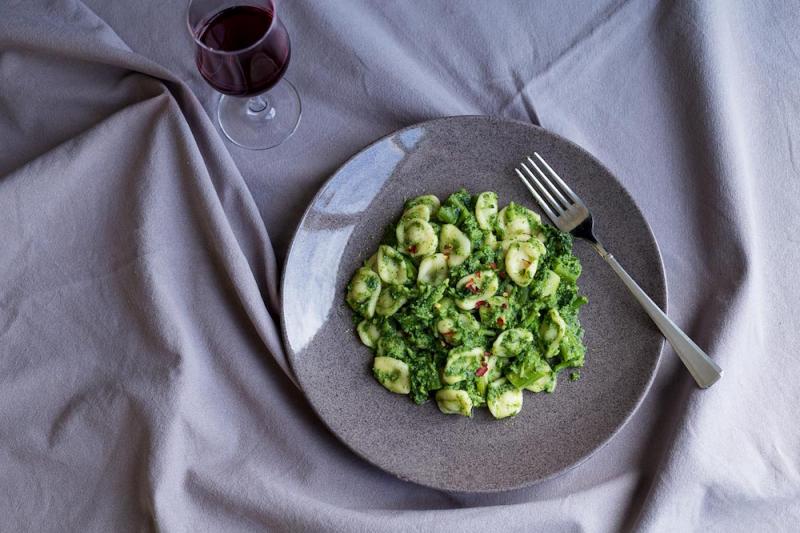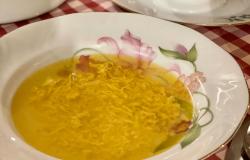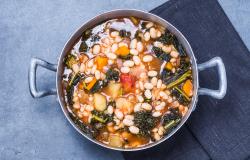Orecchiette con Broccoli Ripassati

I came relatively late to cooking, in my early twenties. After a lifetime of taking the food my Italo-Australian family grew, sourced and cooked with love and pride for granted, I suddenly found myself teaching English in a small town in France's northwest, living alone and, having to cook for myself. Many of the young adults living in the residence I was renting my tiny studio flat in seemed perfectly happy to microwave frozen ready meals and pizzas and subsist on that. Despite my relative lack of experience in the kitchen, I just couldn't bring myself to do the same. One grey autumn morning, I chanced upon the local farmers' market held in the cobblestoned town square. I was told by a local shopper that it was held every Tuesday and Saturday morning. From then on, I made a point of setting aside an hour for food shopping on these days.
Being late autumn, turnips, pumpkins and leeks were in season and graced the stands of the local producers. These were all vegetables my family back home rarely cooked with. Too shy about my French language skills at the time to ask what I could do with them, I opted to buy vegetables that were more familiar to what I'd grown up eating, such as fennel bulbs, cauliflower and my favourite of them all, the verdant, tree-like broccoli.
Over the next few months, on my tiny, two-burner stove top, I learned to replicate, through much trial and error, some of the flavours of the southern Italian dishes from my childhood. Lentil and bean soups featured strongly, as did fennel salads. When my modest budget permitted, I fashioned meatballs from minced meat and leftover bread I'd accumulated. These were then cooked in sauce made from a soffritto of finely chopped onion and tinned tomatoes.
Like this recipe? Than we recommend "Orecchiette: The Signature Pasta from Puglia."
Mastering pasta with broccoli, something my mother made for me regularly in the cooler months of the year back in Australia, gave me the most satisfaction though. Initially, I made it by simply boiling the roughly chopped trunks, leaves and florets together alongside whatever short variety of pasta I had on hand. It was then drained in a colander and coated with the best Italian olive oil I could buy at the time. On the advice of my mother during phone calls back home, I occasionally reserved some of the cooking water to make my plateful of pasta soupier.
It was my then boyfriend's mother, a Sicilian, who introduced me to the act of ripassando or 'twice-cooking' my broccoli. The penny literally dropped as I witnessed her technique with an impossibly beautiful and purple cast specimen at work one evening after Christmas. She boiled her tufts of broccoli for several minutes, scooped them out with a slotted spoon, drained them of excess cooking water in a pasta colander and then added them to a frying pan containing gently-heated olive oil and a clove of garlic swimming in it. As the penne cooked in the leftover green-tinged cooking water, the florets' buds softened and collapsed into the oil and became a sort of sauce. The stalks, though tender enough to be pierced with a fork, remained intact. When the pasta was perfectly al dente, it was drained and added to that frying pan of rendered, almost creamy broccoli.
These days, I like to add a few anchovy fillets and a sprinkling of chilli flakes to that that sublime condiment of creamy broccoli, oil and garlic. I've also found that of all the dizzying variety of short, durum wheat pastas produced in southern Italy, orecchiette (meaning 'little ears') are by far my favourite to pair with this brassica. As Oretta Zanini de Vita and Maureen B. Fant, authors of Sauces and Shapes state, their rough-surfaced, bowl-like shapes lend themselves perfectly to trapping those tiny green buds and other tasty bits. That technique of ripassando or twice cooking, learned that relevatory evening over thirteen years ago, remains the same however.
With the following recipe, feel free to omit the anchovies and chilli if they're not to your liking. Also, I recently discovered that making orecchiette is incredibly easy, with no special equipment, except for a wooden board and a rounded knife, necessary. So, you'll find instructions for making these too. If you don't have an extra hour or so to spare before twice-cooking your broccoli though, you can replace these with packaged dried orecchiette instead. If proceeding this way, be sure to adjust the pasta cooking time indicated.
Ingredients (serves 4 as a starter)
To make the orecchiette, place the sifted durum wheat flour and salt in a large mixing bowl. Make a well in the centre. Gradually add the tepid water while working in the flour with a fork or your fingers. When the flour and water have come together, transfer to a lightly dusted work surface. Knead until the dough is smooth and elastic, at least 10 to 15 minutes. Roll the dough into a ball, cover with plastic wrap or better yet, the mixing bowl and leave to rest for half an hour.
Remove a large fistful of dough from the ball. Cover the remaining dough and roll out the fistful into a long log, about 1 cm thick. Cut the log into pieces about 1 to 1.5 cm in length. Use a rounded, unserrated knife to drag the pieces of dough until they curl up. Reverse the curls so their rough surfaces are facing upwards. Place your fingertip underneath pushing slightly to form the charcteristic cupole or domes (For an excellent visual representation of this process, here is my friend and fellow food writer Carmen Pricone's Instagram video). Place the orecchiette onto a floured tray or teatowel and continue forming the orecchiette with the procedure detailed above until you have used all your dough.
In the meantime, wash, dry and chop your broccoli's florets, stalks and leaves. Bring a large saucepan of salted water to boil, add the broccoli and cook until it can easily be pierced with a fork (about 7 minutes). Use a slotted spoon to remove the broccoli from the boiling water and allow to drain in a bowl lined with a colander. Turn down heat.
Peel garlic. Leave whole for milder flavour. For a stronger aroma, dice finely. Heat olive oil on low to medium heat in a large frying pan. Allow garlic and anchovy fillets (if using) to simmer very gently, bringing down the heat if necessary. Raise heat and add the drained broccoli to the frying pan and leave it to stew for a few minutes. It, along with the anchovy fillets, will render and break up as it cooks.
Bring the broccoli cooking water back to boil, add the orecchiette and cook for 7 to 8 minutes or until the pasta is perfectly al dente. Use the slotted spoon to transfer the orecchiette into the frying pan and combine over a low heat for half a minute. Sprinkle some dried chilli flakes and drizzle some olive oil on top. Turn off heat and toss gently. Serve in warmed bowls or a large serving dish, with some freshly grated pecorino cheese.





